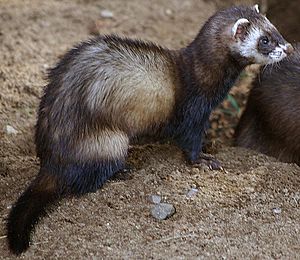Polecat facts for kids
Quick facts for kids Polecat |
|
|---|---|
 |
|
| European polecat | |
| Scientific classification | |
| Kingdom: | |
| Phylum: | |
| Class: | |
| Order: | |
| Family: | |
| Subfamily: |
Mustelinae
|
A polecat is a common name for several types of medium-sized, furry animals. They are all part of the weasel family, called Mustelidae. Even though they share the name "polecat," they are not all the same species. Think of it like how different types of dogs are all called "dogs" but are different breeds.
The European polecat is a well-known type, and it's the only one that naturally lives in the British Isles. Did you know that Ferrets are actually the domesticated (tamed and raised by humans) form of European polecats?
In the United States, some people use the word polecat to describe skunks. This can be confusing because skunks are only distantly related to true polecats. The reason for this mix-up is that polecats, like skunks, can release a very strong smell when they feel threatened. Some people find this smell unpleasant.
Contents
What is a Polecat?
Polecats are small to medium-sized mammals. They are known for their long, slender bodies, short legs, and thick fur. Most polecats are nocturnal, meaning they are active at night. They are also carnivores, which means they eat meat. Their diet usually includes small animals like rodents, birds, and frogs.
Types of Polecats
Scientists group animals into families and then into smaller groups called genera (plural of genus) and species. Polecats belong to the Mustelidae family, which also includes weasels, badgers, and otters. Here are some of the different types of animals known as polecats:
European Polecat
The European polecat (Mustela putorius) is found across Europe. It has dark brown fur with a lighter belly and a dark mask-like pattern around its eyes. These polecats are often found in woodlands, grasslands, and even near farms. They are skilled hunters and can move quickly to catch their prey.
Steppe Polecat
The Steppe polecat (Mustela eversmannii) lives in the grasslands, or steppes, of Eastern Europe and Central Asia. It is usually larger and has lighter, more yellowish fur than the European polecat. Steppe polecats are known for hunting small rodents like marmots and ground squirrels.
Black-footed Ferret (American Polecat)
The Black-footed ferret (Mustela nigripes) is sometimes called the "American polecat." It is native to North America and is one of the most endangered mammals in the world. These polecats have a distinctive black mask, black feet, and a black tip on their tail. They mostly eat prairie dogs and live in their burrows.
Striped Polecat
The Striped polecat (Ictonyx striatus) is found in Africa. It has a very striking appearance with black and white stripes running down its back and a bushy tail. Like other polecats, it can release a strong-smelling liquid from glands near its tail when it feels in danger.
Marbled Polecat
The Marbled polecat (Vormela peregusna) lives in southeastern Europe and Asia. It has a unique fur pattern that looks like marble, with patches of reddish-brown, yellow, and white. Marbled polecats are known for their playful behavior and their ability to climb trees.
Images for kids
-
Black-footed ferret, the “American polecat”




